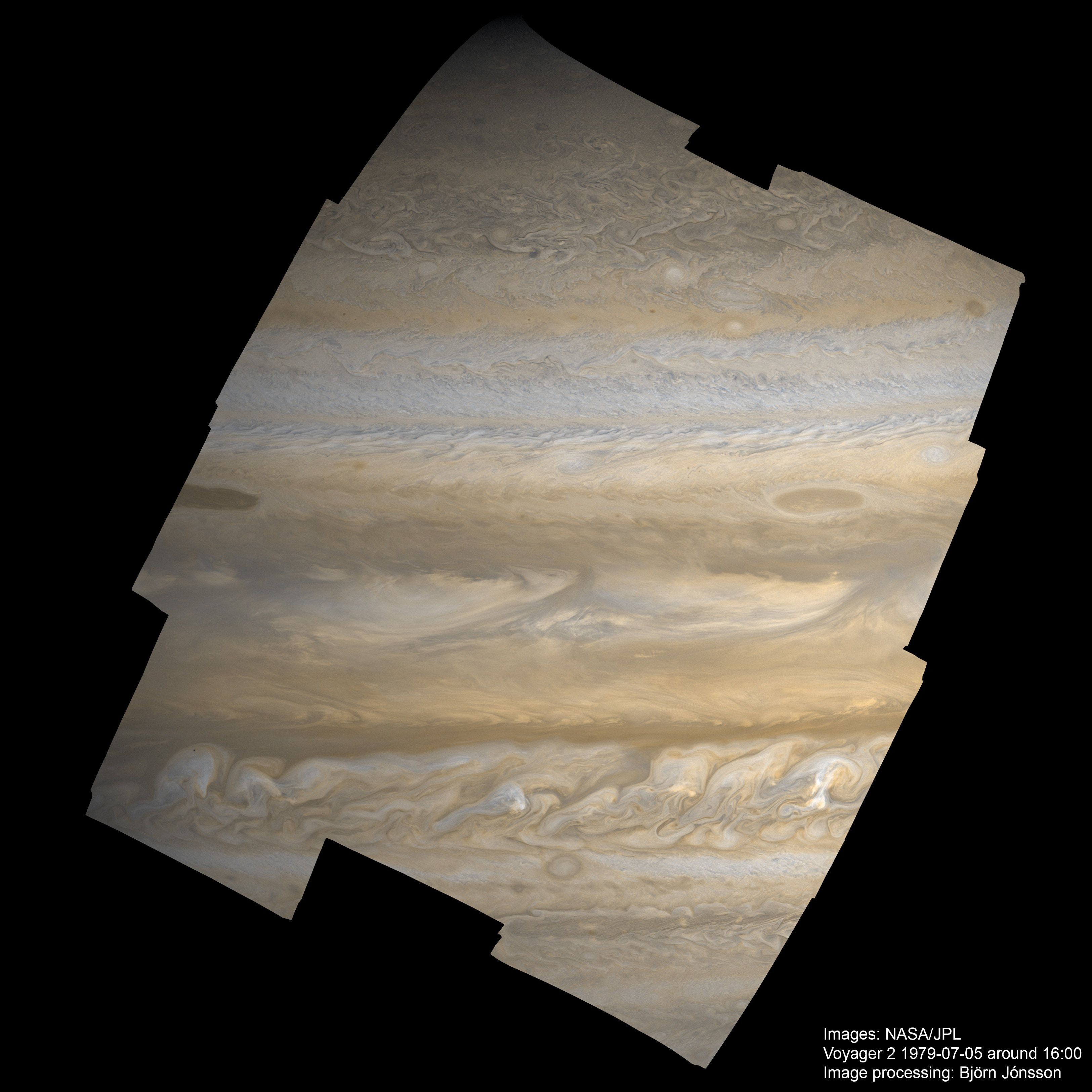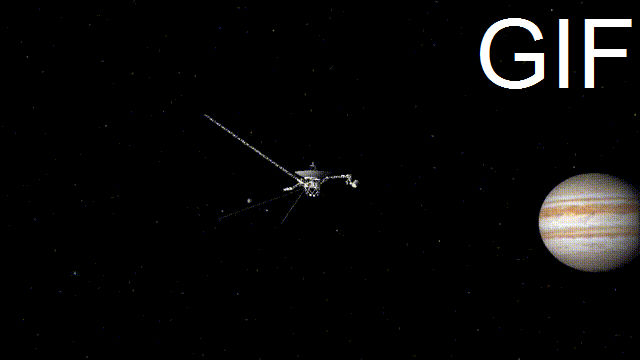- Home
- Voyager 2 Jupiter
Voyager 2 Jupiter
11:05 AM
Voyager 1 and 2: The Interstellar Mission - NASA
The Voyager 1 and 2 spacecraft launched from Earth in 1977. Their mission was to explore Jupiter and Saturn —and beyond to the outer planets of our solar system. This was a big task. No human-made object had ever attempted a journey like that before. The two spacecraft took tens of thousands of pictures of Jupiter and Saturn and their moons

40 Years Ago: Voyager 2 Explores Jupiter | NASA
On July 9, 1979, Voyager 2 made its closest approach to Jupiter, flying within 350,000 miles of the planet's cloud tops. On the outbound leg of its encounter, it imaged the satellite Io (closest approach of 702,200 miles), and conducted a 10-hour volcano watch of the moon, confirming Voyager 1's finding that it harbored active volcanoes
In Depth | Voyager 2 - NASA Solar System Exploration
Voyager 2 is the only spacecraft to study all four of the solar system's giant planets at close range. Voyager 2 discovered a 14th moon at Jupiter. Voyager 2 was the first human-made object to fly past Uranus. At Uranus, Voyager 2 discovered 10 new moons and two new rings. Voyager 2 was the first human-made object to fly by Neptune
Voyager - Jupiter Approach - NASA
Jupiter Approach This time-lapse video records Voyager 1's approach to Jupiter during a period of over 60 Jupiter days. NASA launched the two Voyager spacecraft to Jupiter, Saturn, Uranus, and Neptune in the late summer of 1977. Voyager 1's closest approach to Jupiter occurred March 5, 1979. Voyager 2's closest approach was July 9, 1979
Jupiter from Voyager 2 - NASA Jet Propulsion Laboratory (JPL)
Jupiter from Voyager 2 Dec. 5, 1998 This image was obtained on June 29, 1979, when Voyager 2 was 9.3 million kilometers (5.6 million miles) from the planet. The view extends from +40 to -40 latitude with size of the smallest discernible features equal to 172 kilometers (106 miles)
Voyager 2 - Wikipedia
Voyager 2 ' s closest approach to Jupiter occurred at 22:29 UT on July 9, 1979. [36] It came within 570,000 km (350,000 mi) of the planet's cloud tops. [37] Jupiter's Great Red Spot was revealed as a complex storm moving in a counterclockwise direction. Other smaller storms and eddies were found throughout the banded clouds
Voyager 2 Transformed Our Ideas of Jupiter's Moons 40 Years Ago
Voyager 2's first distant images of Jupiter flowed back on April 24, 1979, and the probe continued taking images and data all the way through Aug. 5 of that year, NASA said. During
Voyager 2: An iconic spacecraft that's still exploring 45 years on
Voyager 2 reached Jupiter in 1979, two years after launching from Cape Canaveral. Since Voyager 1 had just gone through the system four months earlier, Voyager 2's arrival allowed
Voyager 2 view of Jupiter | The Planetary Society
Voyager 2 view of Jupiter Here is a Voyager 2 view of Jupiter that hasn't been seen before. The original data consists of eighteen images, nine each captured through orange and violet filters by Voyager 2 as it approached the greatest planet on June 30, 1979. NASA / JPL / color mosaic by Björn Jónsson

Voyager - Images Voyager took of Jupiter - NASA
Photography of Jupiter began in January 1979, when images of the brightly banded planet already exceeded the best taken from Earth. Voyager 1 completed its Jupiter encounter in early April, after taking almost 19,000 pictures and many other scientific measurements. Voyager 2 picked up the baton in late April and its encounter continued into August
SVS: Voyager 2 Trajectory through the Solar System - NASA
Launched on August 20, 1977, it was one of two spacecraft sent to visit the giant planets of the outer solar system. Like Voyager 1, Voyager 2 flew by Jupiter and Saturn, but the Voyager 2 mission was extended to fly by Uranus and Neptune before being directed out of the solar system
Voyager 1 Sent TERRIFYING Images Of Jupiter After 43 Year!
☄️ Don't forget to SUBSCRIBE: TheSpaceWebSubscribe🚀 For more Space Related Content!The Voyager spacecraft has completely changed the way we
In Depth | Voyager 2 - NASA Solar System Exploration
Voyager 2 is the only spacecraft to study all four of the solar system's giant planets at close range. Voyager 2 discovered a 14th moon at Jupiter. Voyager 2 was the first human-made object to fly past Uranus. At Uranus, Voyager 2 discovered 10 new moons and two new rings. Voyager 2 was the first human-made object to fly by Neptune

Voyager 2 Flies by Jupiter - YouTube
Voyager 2 Flies by Jupiter 56,854 views Jul 31, 2017 323 Dislike Share Save NASA Jet Propulsion Laboratory 1.11M subscribers Excerpt on Jupiter from "The Grand Tour." For more about
Voyager 2 at Jupiter | The Planetary Society
Voyager 2 at Jupiter Voyager 2 mosaic of Jupiter, taken on June 30, 1979 from a distance of 8.74 million kilometers. The image is centered at ~285° longitude. NASA / JPL-Caltech / Justin Cowart Because this mosaic took ~30 minutes to acquire, Jupiter rotated approximately 15 degrees during the acquisition period
Voyager 2 - Interplanetary Missions - NASA Jet Propulsion Laboratory
The Voyager 2 spacecraft, which has been in operation since 1977 and is the only spacecraft to have ever visited Uranus and Neptune, has made its way to interstellar space, where its twin spacecraft, Voyager 1, has resided since August 2012. Visit Mission Website Launch Date Aug. 20, 1977 Type Flyby Spacecraft Target Interstellar Space Status
Voyager - Galleries of Images Voyager Took - NASA
They took more than 33,000 pictures of Jupiter and its five major satellites. The Voyager 1 and 2 Saturn encounters occurred nine months apart, in November 1980 and August 1981. Voyager 1 is leaving the solar system. Voyager 2 completed its encounter with Uranus in January 1986 and with Neptune in August 1989, and is now also en route out of

40 Years Ago: Voyager 2 Explores Saturn | NASA
The spacecraft flew within 350,000 miles of Jupiter's cloud tops on July 9, 1979, and during the four-month encounter returned 17,000 photographs and useful scientific information about the giant planet and many of its moons. Using the giant planet for a gravity assist, Voyager 2 began its 29-month journey to its next destination, Saturn
Voyager - Fact Sheet - NASA
JUPITER Voyager 1 made its closest approach to Jupiter on March 5, 1979, and Voyager 2 followed with its closest approach occurring on July 9, 1979. The first spacecraft flew within 277,400 kilometers (172,368 miles) of the planet's cloud tops, and Voyager 2 came within 650,180 kilometers (404,003 miles)
Voyager 2 Encounters Jupiter (1978) - YouTube
Among the most influential early works of computer animation. Jim Blinn's Voyager simulations would become a staple of television science programming, and
Voyager 2's Observations - Jet Propulsion Laboratory
Voyager 2. Click here to see Voyager 2's view of Jupiter during one of the impacts. The spacecraft is leaving the solar system and will be about 3.7 billion miles (6 billion kilometers) from Jupiter at comet impact. The impact sites will be in the spacecraft's line of sight. Voyager will observe the impacts with an ultraviolet spectrometer and
Post a Comment
Note: Only a member of this blog may post a comment.